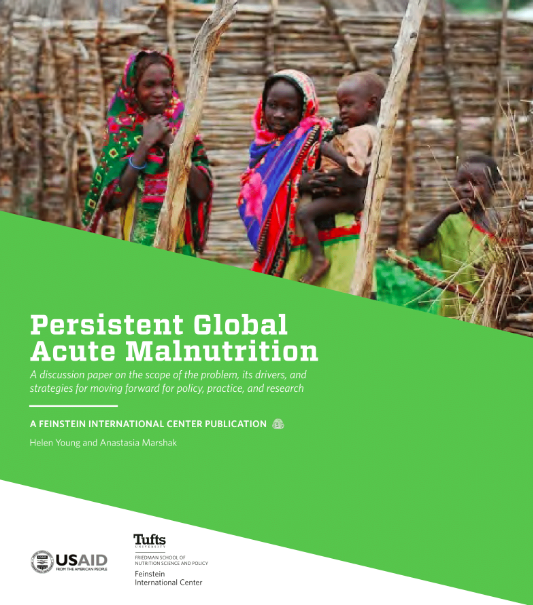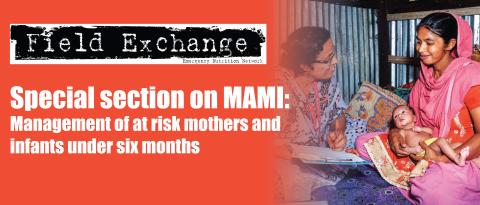Review of scale and drivers of persistent global acute malnutrition
Summary of research1
Location: Global
What we know: The prevalence of global acute malnutrition (GAM) regularly exceeds the emergency threshold of >15% in protracted crises worldwide.
What this article adds: A study involving interviews with 25 key informants and a literature review was undertaken to determine the scale, drivers and analysis constraints of persistent GAM in protracted emergencies. GAM drivers are often unclear and a ‘food-first’ approach persists, despite GAM’s cross-sectoral nature; the UNICEF conceptual framework requires elaboration to apply to protracted emergency contexts. The analysis of persistent GAM is hampered by a lack of comparable data on malnutrition, differences in data pre- and post- World Health Organization (WHO) 2006 growth standards, differences in body shape between populations, and lack of capacity and resources to use the most appropriate methodologies (such as nutrition causal analysis (NCA)). The prioritisation of severe acute malnutrition (SAM), ‘siloed’ sectors and short-term funding cycles create challenges in addressing persistent GAM. The authors recommend prevention as well as treatment in emergencies, nutrition-sensitive programming, better analysis of the root causes of persistent GAM and a greater ‘learning culture’ in this area.
In many protracted emergencies, the prevalence of global acute malnutrition (GAM) regularly exceed the World Health Organization (WHO) emergency threshold of >15%, despite ongoing humanitarian interventions. The widespread scale and long-lasting nature of ‘persistent GAM’ means it is a policy and programming priority. Drawing on 25 interviews with key informants (technical specialists working for international non-governmental organisations (INGOs), United Nations (UN) organisations, academics and donors) and a literature review, this paper describes the scale and duration of the problem of persistent GAM, the perceived causal pathways, the methodological challenges in identifying trends and understanding drivers, and the implications for current practice, policies and future research.
 Interviewees identified 25 countries where persistent GAM is widely recognised as an issue. The most frequently referenced were Somalia, Ethiopia and South Sudan. The Sahel belt and Horn of Africa were the two most consistently highlighted regions. South Asia, including India, Pakistan and Bangladesh, was also mentioned, indicating this problem is not limited to humanitarian contexts but is also evident in more stable development settings, despite wider global improvements in stunting and under-five mortality. Using available survey data, four case studies were developed in places consistently highlighted in the interviews and where GAM rates remain above 15%: Kanem Region, Chad; Cox’s Bazar, Bangladesh; Northern Bahr-el-Ghazal, South Sudan; and Maradi and Zinder Districts, Niger.
Interviewees identified 25 countries where persistent GAM is widely recognised as an issue. The most frequently referenced were Somalia, Ethiopia and South Sudan. The Sahel belt and Horn of Africa were the two most consistently highlighted regions. South Asia, including India, Pakistan and Bangladesh, was also mentioned, indicating this problem is not limited to humanitarian contexts but is also evident in more stable development settings, despite wider global improvements in stunting and under-five mortality. Using available survey data, four case studies were developed in places consistently highlighted in the interviews and where GAM rates remain above 15%: Kanem Region, Chad; Cox’s Bazar, Bangladesh; Northern Bahr-el-Ghazal, South Sudan; and Maradi and Zinder Districts, Niger.
Informants generally agreed that an understanding of the drivers of GAM must inform the design of interventions that address it. The UNICEF conceptual framework, “causes of malnutrition and death”, remains the most well-known and widely adopted. In a protracted crisis, the drivers of persistent GAM are often unclear; in part because the three underlying causes (food, care and health) all potentially play a role. However, a ‘food-first’ focus still tends to dominate thinking and practice in preventing malnutrition in acute emergencies, despite the recognised importance of public health in controlling disease and increasing awareness of care for children and women. Furthermore, evidence in protracted, persistent GAM settings indicates that food security may not be the main driver.
The UNICEF framework requires elaboration to understand the basic causes that apply in protracted emergency contexts, including potentially protracted war, conflict and insecurity; marginalisation; inequalities and poverty; governance of natural resources; and migration and displacement. Four cross-cutting themes emerged from the interviews that are not explicit in the UNICEF framework but are felt to be crucial in understanding persistent GAM: gender; livelihood systems; the history of vulnerability and long-term trends driving acute malnutrition; and seasonal fluctuations in acute malnutrition.
There are several methodological challenges in studying persistent GAM. First, there is limited availability of reliable and comparable data on acute malnutrition, across time and populations. Second, the switch from the National Center for Health Statistics (NCHS) anthropometric reference data to WHO growth standards in 2006 had implications for comparability over time. Specifically, important differences have been observed in the weight-for-height z-score (WHZ) cut-offs used for defining acute malnutrition between the two growth standards, with WHO standards resulting in higher prevalence estimates of SAM by 3% (Seal and Kerac, 2007). Another potential challenge is the slight differences in body shape that have been observed among children over two years of age from different populations, which associates longer-limbed body types with pastoralist populations in hotter, semi-arid environments. WHO guidelines do not address the possibility that physiological differences result in different malnutrition estimates in children and no clear guidance exists on how to correct for this.
Various approaches are used for analysing the drivers of malnutrition, ranging from household surveys to qualitative approaches and mixed methods. While surveys can be used for testing correlations and regression analysis, a general lack of capacity and resources tends to limit this approach in practice. Both localised surveys and qualitative methods suffer in that results are not generalisable.
Recent methodological advances include a new participatory and response-oriented methodology known as Link-Nutrition Causal Analysis (NCA), which has now been applied in over 30 settings. Identified strengths of this approach are that it can bring together stakeholders, raise awareness and build consensus. However, the issue of response analysis and uptake of findings remains a challenge for all methodologies.
Addressing persistent GAM presents particular challenges for operational agencies, in part as a result of structural issues within the humanitarian system, such as the focus on treatment of severe acute malnutrition, ‘siloed’ sectors and short-term funding cycles that do not include NCA or prioritise prevalence data.
The paper offers some potential strategies for moving forward. First, treatment and prevention should go hand-in-hand at all stages of an emergency; second, nutrition-sensitive programmes based on partnership, localisation and more participatory ways of working should be adopted as common practice; third, the root causes of persistent GAM linked with the wider political economy and protracted crisis should be more seriously analysed; fourth, a learning culture linked to research uptake and response analysis should be promoted.
This last point is linked to a proposed research agenda to strengthen the evidence base to guide programmes and policies. Important research gaps highlighted in this review relate to further analysis of wasting trends and, linked with this analysis, the relationship between wasting, stunting and mortality. A major area for future research is further investigations of specific pathways associated with wasting, including the role of environmental enteropathy pathogens, the microbiota and the role of pre-existing nutritional status on child wasting.
The authors conclude that the challenge of persistent GAM is verging on a systemic crisis untouched by nutrition-specific programming, which calls for a radical reassessment of how we address nutrition in protracted crises.
Endnote
1Young H and Marshak A. Persistent Global Acute Malnutrition. Boston: Feinstein International Center, Tufts University, 2017.
References
Seal A and Kerac M. 2007. Operational implications of using 2006 World Health Organization growth standards in nutrition programmes: Secondary data analysis. BMJ 334 (7596): 733.
Other recent papers by Feinstein International Center include:
Maxwell D, Stites E, Robillard SC, Wagner M. Conflict and Resilience: A Synthesis of Feinstein International Center Work on Building Resilience and Protecting Livelihoods in Conflict-related Crises. Boston: Feinstein International Center, Tufts University, 2017.
Catley, A. Pathways to Resilience in Pastoralist Areas: A Synthesis of Research in the Horn of Africa. Boston: Feinstein International Center, Tufts University, 2017.
Available from: http://fic.tufts.edu/publications/


